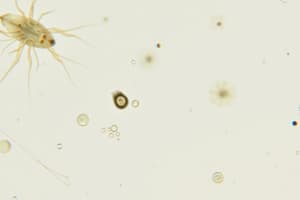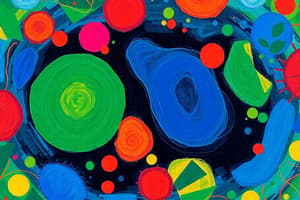Podcast
Questions and Answers
What reserve food do members of the Rhodophyceae class primarily use?
What reserve food do members of the Rhodophyceae class primarily use?
- Floridean starch (correct)
- Mannitol
- Sugars
- Fats
What structure is characteristic of Ascomycetes for spore production?
What structure is characteristic of Ascomycetes for spore production?
- Basidia
- Zygospores
- Asci (correct)
- Carpospores
Which class of fungi is known for the absence of a known sexual reproductive stage?
Which class of fungi is known for the absence of a known sexual reproductive stage?
- Deuteromycetes (correct)
- Ascomycetes
- Basidiomycetes
- Zygomycetes
Which of the following is a common example of Zygomycetes?
Which of the following is a common example of Zygomycetes?
What type of reproduction is predominant in Cyanophyceae?
What type of reproduction is predominant in Cyanophyceae?
Which pigment is primarily found in Rhodophyceae, masking the chlorophyll?
Which pigment is primarily found in Rhodophyceae, masking the chlorophyll?
What is the primary means of reproduction for diatoms?
What is the primary means of reproduction for diatoms?
Which pigment is characteristic of dinoflagellates?
Which pigment is characteristic of dinoflagellates?
What is the habitat of Basidiomycetes?
What is the habitat of Basidiomycetes?
What type of structure do dinoflagellates have that serves as a cell covering?
What type of structure do dinoflagellates have that serves as a cell covering?
What type of life cycles do fungi typically exhibit?
What type of life cycles do fungi typically exhibit?
Which class of algae is primarily found in freshwater and has bright green chromatophores?
Which class of algae is primarily found in freshwater and has bright green chromatophores?
What is the reserve food in chloromonadineae?
What is the reserve food in chloromonadineae?
What type of flagella do cryptophyceae possess?
What type of flagella do cryptophyceae possess?
Which class of algae is known for dominating rocky shores in colder waters?
Which class of algae is known for dominating rocky shores in colder waters?
What reproduction type is indicated for chloromonadineae?
What reproduction type is indicated for chloromonadineae?
What characteristic differentiates protozoans from other eukaryotes?
What characteristic differentiates protozoans from other eukaryotes?
Which type of reproduction occurs in some forms of Apicomplexa?
Which type of reproduction occurs in some forms of Apicomplexa?
What is the main function of the pellicle in certain protozoans?
What is the main function of the pellicle in certain protozoans?
Where are protozoans commonly found?
Where are protozoans commonly found?
What term is used for the feeding and multiplying stage of parasitic protozoa?
What term is used for the feeding and multiplying stage of parasitic protozoa?
Which of the following is NOT a classification of protozoans?
Which of the following is NOT a classification of protozoans?
What type of nutrition do parasitic protozoa primarily require?
What type of nutrition do parasitic protozoa primarily require?
What is a defining feature of the Sporozoa classification?
What is a defining feature of the Sporozoa classification?
Which of the following classes of algae is characterized by having pigments such as chlorophylls a and c, and an accessory pigment fucoxanthin?
Which of the following classes of algae is characterized by having pigments such as chlorophylls a and c, and an accessory pigment fucoxanthin?
What type of cell wall composition is found in the class of algae known as Chlorophyceae?
What type of cell wall composition is found in the class of algae known as Chlorophyceae?
Which statement correctly describes the reproductive characteristics of Xanthophyceae?
Which statement correctly describes the reproductive characteristics of Xanthophyceae?
Which of the following algae classes predominantly inhabit freshwater environments and may also be found in cold freshwater?
Which of the following algae classes predominantly inhabit freshwater environments and may also be found in cold freshwater?
What distinguishes the cell structure of Bacillariophyceae?
What distinguishes the cell structure of Bacillariophyceae?
Which characteristic is NOT true for the algal cell structure?
Which characteristic is NOT true for the algal cell structure?
Which of the following classes of algae is characterized by isogamous sexual reproduction?
Which of the following classes of algae is characterized by isogamous sexual reproduction?
What is the primary form of stored food in Chrysophyceae?
What is the primary form of stored food in Chrysophyceae?
Flashcards
What are Protozoans?
What are Protozoans?
Unicellular, eukaryotic organisms that lack a cell wall and are either free-living or parasitic. They are often found in aquatic environments, with some being aerobic and others anaerobic.
What is a trophozoite?
What is a trophozoite?
The active feeding and multiplying stage of parasitic protozoa.
What is a cyst?
What is a cyst?
A stage of some protozoa with a thick, protective membrane or wall. They are often resistant to harsh environments.
What are Mastigophora?
What are Mastigophora?
Signup and view all the flashcards
What are Sarcodina?
What are Sarcodina?
Signup and view all the flashcards
What are Sporozoa?
What are Sporozoa?
Signup and view all the flashcards
What are Ciliophora?
What are Ciliophora?
Signup and view all the flashcards
What are Algae?
What are Algae?
Signup and view all the flashcards
Diatoms (Bacillariophyceae)
Diatoms (Bacillariophyceae)
Signup and view all the flashcards
Cryptophytes (Cryptophyceae)
Cryptophytes (Cryptophyceae)
Signup and view all the flashcards
Dinoflagellates (Dinophyceae)
Dinoflagellates (Dinophyceae)
Signup and view all the flashcards
Chloromonads (Chloromonadineae)
Chloromonads (Chloromonadineae)
Signup and view all the flashcards
Euglenoids (Euglinineae)
Euglenoids (Euglinineae)
Signup and view all the flashcards
Brown Algae (Phaeophyceae)
Brown Algae (Phaeophyceae)
Signup and view all the flashcards
Polyphyletic
Polyphyletic
Signup and view all the flashcards
Algae
Algae
Signup and view all the flashcards
Class Chlorophyceae (Green Algae)
Class Chlorophyceae (Green Algae)
Signup and view all the flashcards
Class Xanthophyceae (Yellow-green Algae)
Class Xanthophyceae (Yellow-green Algae)
Signup and view all the flashcards
Class Chrysophyceae (Golden Algae)
Class Chrysophyceae (Golden Algae)
Signup and view all the flashcards
Class Bacillariophyceae (Diatoms)
Class Bacillariophyceae (Diatoms)
Signup and view all the flashcards
Fritsch's Algal Classification
Fritsch's Algal Classification
Signup and view all the flashcards
Phycology
Phycology
Signup and view all the flashcards
Rhodophyceae (Red Algae)
Rhodophyceae (Red Algae)
Signup and view all the flashcards
Cyanophyceae (Blue-Green Algae)
Cyanophyceae (Blue-Green Algae)
Signup and view all the flashcards
What are Fungi?
What are Fungi?
Signup and view all the flashcards
Criteria for Fungi Classification
Criteria for Fungi Classification
Signup and view all the flashcards
Zygomycetes
Zygomycetes
Signup and view all the flashcards
Ascomycetes
Ascomycetes
Signup and view all the flashcards
Basidiomycetes
Basidiomycetes
Signup and view all the flashcards
Deuteromycetes
Deuteromycetes
Signup and view all the flashcards
Study Notes
Protozoa
- Protozoa are unicellular, eukaryotic, and heterotrophic organisms.
- They exist as either free-living or parasitic.
- There are about 65,000 species categorized into different groups.
- They lack a cell wall.
Protozoan Characteristics
- Habitat: Found in aquatic environments (freshwater, oceans), some are parasitic in plants and animals, many are aerobic but some anaerobic in the rumen or human intestine.
- Size and Shape: Vary greatly, from microscopic (1µm) to visible by the naked eye. Some, especially ciliates, have a pellicle which provides a defined shape and aids locomotion.
- Cellular Structure: Unicellular with a eukaryotic cell. Metabolic functions carried out by specialized internal structures.
Protozoan Classification
- Mastigophora (Flagellated): Example: Trypanosoma (diagram shows flagellum, mitochondria, basal body, and kinetoplast)
- Sarcodina (Amoeboids): Example: Amoeba (diagram shows food vacuole, pseudopodia, ectoplasm, entoplasm, plasmagel, and plasmosol)
- Sporozoa (Sporozoans): Example: Plasmodium (diagram shows mitochondria, apicaplast, microtubules, pellicular cisterna, plasma membrane, merozoite, coat, nucleus, dense granules, ribosomes, apial end, and rhoptry)
- Ciliophora (Ciliated): Example: Paramecium (diagram shows pellicle, oral groove, buccal overture, cell mouth, anal pore, cytoproct, contractile vacuole, micronucleus, and macronucleus)
Protozoan Life Cycle Stages and Reproduction
- Life Cycle Stages: Trophozoites are stages of actively feeding and multiplying protozoa. Cysts have protective membranes or thickened walls and are resistant in tissues.
- Reproduction: Binary fission and multiple asexual division occur in some forms. Both sexual and asexual reproduction occurs in Apicomplexa.
Protozoan Nutrition
- All parasitic protozoa require preformed organic substances. Nutrition is holozoic, like in higher animals.
Algae
- "Alga" describes a diverse group of eukaryotic photosynthetic organisms.
- They lack a shared common ancestor and are therefore not all related.
Algal Characteristics
- Cells: Eukaryotic. Cell walls composed of mannans, cellulose, and galactans.
- Photosynthetic: Produce their own food using light energy.
- Form: Can be unicellular or multicellular
- Environment: Occur where there's adequate moisture.
- Reproduction: Asexual and sexual reproduction.
- Free-living: Algae are independent organisms.
Algal Classifications (Examples)
- Chlorophyceae (Green Algae): Chlorophyll a and b; Example: Halimeda spp., Chlamydomonas (diagram shows chloroplast and the structural components of algae)
- Xanthophyceae (Yellow-green Algae): Xanthophyll pigment; Example: Vaucheria
- Chrysophyceae (Golden algae): Chlorophylls a & c, with accessory pigments; Example: Chrysodendron
- Bacillariophyceae (Diatoms): Unique cell walls made of opaline silica (diatom frustule)
- Cryptophyceae: Flagella, slightly unequal, coccoid form; Example: Chroomonas
- Dinophyceae (Dinoflagellates): Chlorophylls a & c with golden brown pigments like peridinin and a two-flagellated structure; Example: Dinoflagellate Ceratium (also notes on red tides and neurotoxins).
- Chloromonadineae: Freshwater; xanthophyll, motile, two almost equal flagella
- Euglinineae: Freshwater; pure green chromatophores; motile flagella, one or two; Isogamous; polysaccaride and paramylon reserve food
- Phaeophyceae (Brown Algae): Fucoxanthin pigment; Example: Sargassum
- Rhodophyceae (Red Algae): Masked chlorophyll; phycobilin pigments; multicellular, no flagella; Floridean starch reserve food; Example: Polysiohonia
- Cyanophyceae (Blue-green Algae): Phycobilins; no proper chromatophores or motile stages; Sugars and glycogen reserves; Example: Spirulina
Fungi
- Fungi are a diverse group of eukaryotic organisms.
- They lack chlorophyll and obtain nutrients through absorption.
- Common forms include yeasts, molds, and mushrooms
- Can be unicellular or multicellular
- Cell walls made of chitin
- Wide range of morphological forms and sizes
Fungal Classification Criteria
- Structure of reproductive organs
- Type of spores
- Mode of reproduction (sexual/asexual)
- Habitat (parasitic, saprophytic, mutualistic)
Major Groups of Fungi
- Zygomycetes: Terrestrial, soil and decaying matter, form thick-walled spores (zygotes). Example: Rhizopus (bread mold)
- Ascomycetes: Largest group, produce spores in sac-like asci. Examples: Saccharomyces, Penicillium, Aspergillus
- Basidiomycetes: Spores produced on club-shaped basidia. Examples: Agaricus, Amanita, Coprinus
- Deuteromycetes: "Imperfect Fungi"; Lack a known sexual reproductive stage. Examples: Candida, Trichophyton (athlete's foot)
Studying That Suits You
Use AI to generate personalized quizzes and flashcards to suit your learning preferences.
Related Documents
Description
Explore the fascinating world of protozoa with this quiz. Discover their characteristics, habitat, cellular structure, and various classifications such as Mastigophora and Sarcodina. Test your knowledge on these unicellular eukaryotic organisms that play significant roles in their ecosystems.



